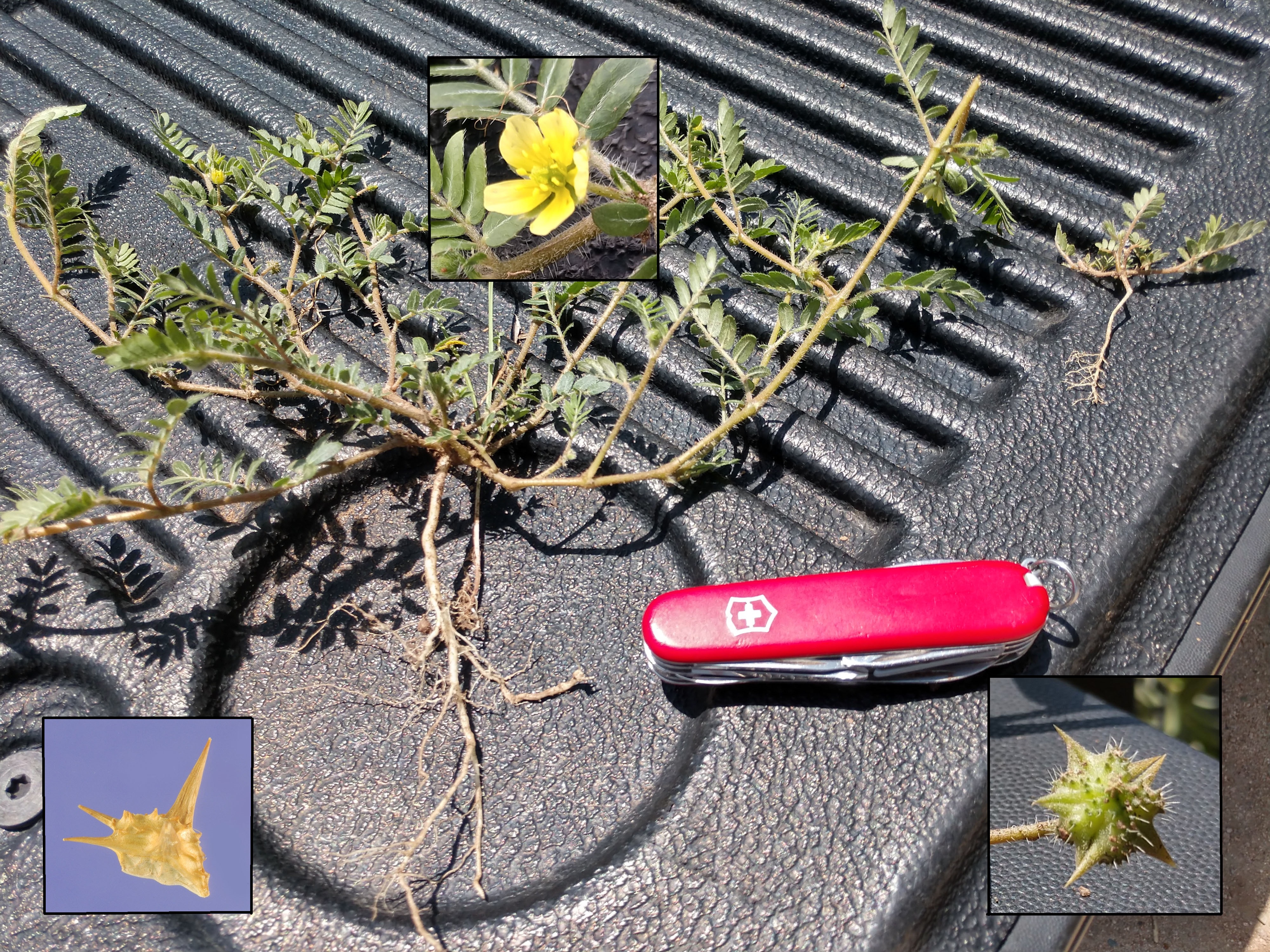 Managing Puncturevine - August 7, 2019 Jeff Schalau, Agent, Agriculture & Natural Resources University of Arizona Cooperative Extension, Yavapai County Puncturevine (Tribulus terrestris) is a warm season, broadleaf annual weed sometimes called “goat head.” It grows in disturbed areas and vacant lots and can be found throughout Arizona at elevations below 6,500 feet. Puncturevine is a low-growing, mat-forming plant with small leaflets that resemble small mesquite leaves. It has one-half inch wide yellow flowers and trailing stems that may reach one to six feet long in the summer. Hard spiny burs about one-half inch wide develop after the spiny fruits ripen. The spiny burs contain seeds. When the burs stick into shoes, tires, animals and other moving objects, they are dispersed into new areas where new populations can establish. Viable seeds can also lie dormant in soil for up to 20 years. The best and easiest way to manage puncturevine is to use a scuffle hoe (or stirrup hoe) to gently sever the taproot and gently pick up the plant and discard it without dislodging any ripened seeds. It is best to do this when the plant is young and before it flowers. If puncturevine is increasing on your property, learn to recognize it and remove it before early in summer. If you have large areas of puncturevine, you may want to consider selecting additional management strategies. Puncturevine thrives on disturbance. Typical situations are overgrazed horse pastures and frequently disturbed areas (parking, high traffic, disturbed soil, etc.). Minimizing future disturbance will stabilize the site and planting the area with warm season, native grasses will promote competition and squeeze out puncturevine over time. In some situations, you may also reduce puncture vine through prevention. Prevention strategies include checking incoming seed sources such as tires, shoes, contaminated hay, and animals. If I see puncturevine on my property, it is always where we park the cars. Applications of 4-6 inches of organic mulch or synthetic weed barriers are effective at managing puncturevine. Propane burners can also be effective in reducing the numbers of viable puncturevine seed left on the soil surface. I would recommend discussing this method with your local fire department before using or purchasing a propane burner. Chemical control is generally not necessary for the control of puncturevine in the home landscape. However, in large areas, or places where there was a heavy infestation in previous years so that it’s difficult to remove by hand, hoeing, or tilling, herbicides may be used to control puncturevine. Pre-emergent herbicides containing oryzalin, benefin, or trifluralin applied in spring (April 1) will kill seedlings as they germinate during the subsequent summer. This strategy is best where you do not want desirable grasses and forbs to grow in and compete with the puncturevine as it will kill desirable plant seedlings as they germinate too. Once plants have emerged from the soil (postemergent), products containing 2,4-D, glyphosate, and dicamba are effective on puncturevine. The smaller or younger the plant, the better the postemergent herbicides work. Dicamba and 2,4-D will injure most broadleaf plants so it is important that they only be applied to the weeds and drift is minimized. A distinct advantage of 2,4-D and dicamba is that they do not adversely affect established grass plants that may inadvertently get sprayed. They can be applied to lawns without injuring the desired grass. Glyphosate will kill or injure most plants so it should only be used as spot treatments or on solid stands of the weed. You may also consider using “least toxic” herbicides such as acetic acid, clove oil, pelargonic acid. Do not use home remedies with vinegar and salt as these are ineffective and may cause soil degradation. In the past, I’ve also recommended a biocontrol strategy that uses two different weevils – one colonizes the fruits and kills the seed and another that mines the stem and weakens the plant. I have never heard of these weevils being available for shipment into Arizona. These would only be effective where there are large infestations (acres) of puncturevine and would not eradicate the population. They are used where other strategies are also being used and primarily prevent the spread of established populations. I learned to recognize this plant as a child and I’ve hated it ever since. I suggest you also learn to recognize it and use the recommended strategies I’ve presented above. I’ve included photos and additional information below. You can follow the Backyard Gardener on Twitter – use the link on the BYG website. If you have other gardening questions, call or email the Master Gardener help line in the Prescott (928-445-6590/prescottmg@gmail.com) or Camp Verde (928-554-8992/verdevalleymg@gmail.com) and be sure to include your name, address and phone number. Find past Backyard Gardener columns or provide feedback at the Backyard Gardener web site: http://cals.arizona.edu/yavapai/anr/hort/byg/. Photo  Small and medium sized puncturevine (Tribulus terrestris) plants showing taproots, flower (upper center), developing fruit (lower right), and dried fruit (lower left) which displays spines and encloses the seed (Jeff Schalau, University of Arizona).
Small and medium sized puncturevine (Tribulus terrestris) plants showing taproots, flower (upper center), developing fruit (lower right), and dried fruit (lower left) which displays spines and encloses the seed (Jeff Schalau, University of Arizona).Additional Resources Puncturevine Management Guidelines, University of California Agriculture and Natural Resources ipm.ucanr.edu/PMG/PESTNOTES/pn74128.html Puncturevine, Washington State University Extension cru.cahe.wsu.edu/CEPublications/PNW0133/PNW0133.pdf Identification and Management of Puncturevine, University of Nevada Cooperative Extension www.unce.unr.edu/publications/files/nr/2003/FS0334.pdf |